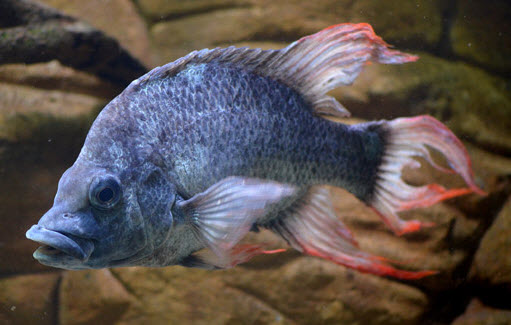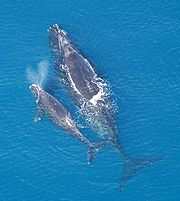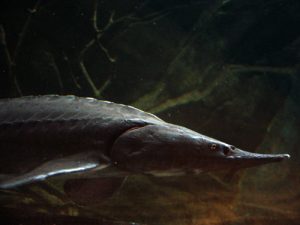Category Archives: Endangered
New Population of Mangarahara Cichlid, Ptychochromis insolitus found
The Mangarahara cichlid is known as one of the most endangered cichlids in the world. The Zoological Society of London (ZSL) thought that their two males, together with one fish at the Berlin Zoo might be the last 3 in the world. In a hope to try to save this species they reached out to the public and aquarists around the world to see if anyone had a female Mangarahara cichlid. Continue reading
Florida researchers use satellites to find out more about the elusive Hammerhead shark
Using satellite tag technology, research assistant professor Neil Hammerschlag and his colleagues have tracked a hammerhead shark during 62 days, as it journeyed from the southern coast of Florida to the middle of the Atlantic off the coast of New Jersey.
The straight line point-to-point distance turned out to be 1 200 kilometers (745 miles).
“This animal made an extraordinary large movement in a short amount of time,” says Hammerschlag, director of the R.J. Dunlap Marine Conservation Program at the University of Miami Rosenstiel School of Marine & Atmospheric Science. “This single observation is a starting point, it shows we need to expand our efforts to learn more about them.”
The hammerhead is believed to have been following prey fish off the continental slope, and it was probably prey that caused it to enter the Gulf Stream current and open-ocean waters of the northwestern Atlantic.
The study headed by Hammerschlag is a part of a larger effort to satellite track tropical sharks to find out if any areas are especially important for their hunting, mating and rearing of young. Hammerschlag also wish to document their migration routes.
“This study provides evidence that great hammerheads can migrate into international waters, where these sharks are vulnerable to illegal fishing,” says Hammerschlag. “By knowing the areas where they are vulnerable to exploitation we can help generate information useful for conservation and management of this species.”
More information can be found in the paper “Range extension of the Endangered great hammerhead shark Sphyrna mokarran in the Northwest Atlantic: preliminary data and significance for conservation“, published in the current issue of Endangered Species Research. The paper’s co-authors include Hammerschlag, Austin J. Gallagher and Dominique M. Lazarre of the University of Miami and Curt Slonim of Curt-A-Sea Fishing Charters.
Scientists use sedation to free young entangled Right Whale
Scientists from NOAA and its state and nonprofit partners have applied at-sea chemical sedation to successfully free a young North Atlantic Right Whale off the coast of Cape Canaveral in Florida, USA.
This is only the second time a free-swimming whale has been successfully sedated to enable disentanglement. The first case also concerned a whale spotted off the coast of Florida and occurred in March 2009.
In the most recent case, a female Right Whale born during the 2008-2009 calving season had roughly 200 feet (60 meters) of rope wrapped through her mouth and around the flippers when an aerial survey team spotted her on December 25. Five days later a disentanglement team from Georgia Department of Natural Resources and Florida Fish and Wildlife Conservation Commission was able to remove about 150 feet (45 meters) of rope from her. Unfortunately, they couldn’t safely get the rest of the rope off her and this is why NOAA decided to sedate her, after having tracked her via satellite tag for half a month to see if the remaining rope would come off on its own.
“Our recent progress with chemical sedation is important because it’s less stressful for the animal, and minimizes the amount of time spent working on these animals while maximizing the effectiveness of disentanglement operations,” says Jamison Smith, Atlantic Large Whale Disentanglement Coordinator for NOAA’s Fisheries Service. “This disentanglement was especially complex, but proved successful due to the detailed planning and collective expertise of the many response partners involved.”
On January 15, researchers deemed that the Right Whale wouldn’t be able to free herself from the remaining 50 feet (15 meters) of rope without assistance. The weather was favorable for a rescue mission and a disentanglement team comprised of scientists from NOAA, Georgia Department of Natural Resources, Florida Fish and Wildlife Conservation Commission, Woods Hole Oceanographic Institution, University of Florida, EcoHealth Alliance , and Coastwise Consulting (was dispatched into the Atlantic. Back on shore, the Provincetown Center for Coastal Studies and the New England Aquarium got ready to provide off-site assistance.
The entangled Right Whale was fitted with a temporary satellite tag that would record her behavior before, during and after sedation. She was then sedated and had ropes as well as mesh material removed from her. The mesh resembled mesh used to catch fish, crabs and lobsters along the Atlantic coast and NOAA’s Fisheries Service is currently examining it in an effort to determine its geographic origin.
Once the whale had been freed from the garbage, the researchers administered a drug that reversed the sedation. The whale also received some antibiotics to threat the wounds caused by the debris. She will now be tracked for up to 30-days through the temporary satellite tag.
If you see an entangled or otherwise injured whale you are encouraged to report it to the Florida Fish and Wildlife Conservation Commission (1-888-404-FWCC or 1-888-404-3922) or the Georgia Department of Natural Resources (1-800-2-SAVE-ME or 1-800-272-8366).
Minister Raises Alarm Over Armed Whaling Ships
Foreign Minister McCully has raised the alarm to anti-whaling protesters that ships of Japanese origin will be armed to the teeth, and cautions activists to keep an eye out.
Cold Spell in Florida Kills 699 Manatees in 2010: “Warm Water Sites” in Dire Need
The cold spells experienced earlier on in the year have resulted in the record for killed manatees in 2010. Since the beginning of the year, up until the 5th of December, researchers with the Florida Fish and Wildlife Conservation Commission’s Fish and Wildlife Research Institute has counted a staggering 699 dead manatees floating about in state waters.
This number of deaths is double the average of killed manatees over the past half decade.
It was quite a shock to see so many cold related manatee deaths this year. What’s more astonishing that the number, is how far it was spread out. It spread throughout much of the State of Florida to as far south as the Everglades and even the Florida Keys – which aren’t normally known for cold related deaths of manatees.
Even though this cold spell was natural, the number of manatee deaths has drawn attention to the fact that warmer waters are needed for the species to pull through.
“We are very concerned about the unusually high number of manatee deaths this year. Data from our monitoring programs over the next few years will tell us if there are long-term implications for the population,” explains Gil McRae, the director of FWRI.”The cold-related deaths this past winter emphasize the importance of warm-water habitat to Florida’s manatees. Maximizing access for manatees to natural warm-water sites will continue to be a focus for the FWC and our partners moving forward.”
While there hasn’t been any forthcoming suggestions, there will be more research done into the matter and a solution proposed, hopefully sooner rather than later.
Ringed And Bearded Seals Proposed to be Listed Under Endangered Species Act, Proposed by NOAA
NOAA’s Fisheries Service has proposed that four subspecies of ringed seals – which generally are found in the Arctic Basin and the North Atlantic – and two distinct populations of bearded seals – who make their home in the Pacific Ocean – be placed on the threatened list under the Endangered Species Act.
The reasoning behind putting these animals on the threatened list is due to disappearing sea ice, and diminishing snow cover. The models used to predict the amount of sea ice and snow in the future were from NOAA.
It’s not such a strange request. You see, one of the subspecies of ringed seals is already on the ESA endangered list. Under the new rules proposed by the Federal Register, the other four subspecies of the ringed seals would also be listed as being threatened.
The pups of the ringed seals are generally born in snow caves in the early spring, and are susceptible to low temperatures and being eaten by predators if they don’t have the snow caves for shelter. The changing climate can reduce the amount of snow cover, and rising temperatures can change when the ice breaks up every spring. However, the biggest reason that the ringed seals are being put on the list is that they only give birth to one pup every year, and this can make it hard for them to bounce back from harsh challenges imposed by the rapidly changing climate.
Much for the same reasons, the bearded seal has also been proposed to fall into the same category.
Black Caviar Back on Market – If You’re Willing to Pay
OK you fish egg fanatics, some good news – black caviar can once again be purchased for your upscale parties. It is available on the shelves in Russia for the first time since it was taken off the menu back in 2007.
It was taken off the market in Russia due to concern for the survival of the sturgeon, who were under constant attack from poachers for the delectable delicacy.
However, now it is back on the market, even though the sturgeon is not yet out from under the cloud of extinction, and officials are keeping their fingers crossed that the competition in the commercial market may just help put an end to the black market of black caviar.
The ban on the sale of black caviar was supposed to help encourage people to start caviar farms – what can we say, good old Russian logic – which were supposed to use breeding techniques approved during the reign of the Soviet Union.
That being the case, black caviar farms remained under developed in Russia, and only one out of every five of them actually produces the delectable black tidbits. The rest of the black caviar comes from smuggling and poaching operations, Itogi reported.
After three years going down this path proved to not be getting the desired effect as the demand for the black caviar simply made prices skyrocket, and cases of poaching and smuggling became more abundant.
While black caviar has been put back on the market, the red caviar is expected to be the choice this Christmas and New Years’, given that the price is much easier on the purse strings.
French ministry blocked in protest by Plastic Tuna?!?
Just when you think things can’t get any weirder, France one ups you… Some activists from Greenpeace have utilized a car with what appears to be a gigantic plastic tuna on top to block off the main entrance to the Agriculture and Fisheries Ministry in France this past Wednesday, to help insight interest in the fact that there has been a steep decline of the Atlantic bluefin tuna populations.
Environmentalists have claimed that the bluefin tuna are being overfished and their populations are in steep decline in both the Eastern Atlantic as well as the Mediterranean. The ICCAT – International Commission for the Conservation of Atlantic Tunas –, which is in charge of regulating trade of the fish on the international markets, is to convene in Paris from the 17th of November until the 27th.
The French branch of Greenpeace is accusing the government of France – much in the “J’Accuse!” style – of placing the wants and needs of the commercial fisheries ahead of the needs and wellbeing of the fish themselves.
The vehicle that these GreenPeace activists so cleverly had dressed up with a big plastic tuna, also bares the message “Save me!”. The tuna was being kept in place by an activist who was laying loosely on top of the car.
People who had business to attend to in the ministry, simply had to use the other entrances.
Gollum Risking Extinction in New Zealand, Frodo Can’t Help Him
A unique, and hard to find, fished which is named after a J.R.R. Tolkien character is facing extinction if the plans to build a dam come to fruition. You see, it happens to only live in that one river in New Zealand, and cannot be transplanted easily.
Gollum galaxias, fifteen centimeters in length, can only really be seen on Stewart Island in New Zealand. Pioneer Generation Ltd., a local power company, wants to build a hydroelectric plant, but this would effectively destroy the Gollum’s home, the Nevis River.
The company is overlooking plans to make an appeal of the government decision to ban making a dam on the river.
A special tribunal was formed to discus the fate of the Gollum’s home and it was decided that it “is very clear that damming the Nevis River would also damn the Gollum to permanent extinction” Russel Norman, of the New Zealand Green Party commented to Scoop Independent News.
The DOC – New Zealand Department of Conservation – had already said that the Gollum was “nationally vulnerable”. However, the DOC had absolutely nothing to do with the decision to block the power company from making its dam, and damning the Gollum in the process. That decision was made following requests that the character of the Nevis River be preserved.
It looks like the Gollum is safe for now, but how long will it be before someone gives in, and starts lobbying for a new power station, as opposed to a fish?
Fisherman Gets Sent Up the River For Taking Shot at Sea Lion:
A fisherman from Northern California who took out his frustrations on a sea lion last year, has just been sentenced this past Friday to one month in jail and to pay $51,000 in restitution.
Larry Allen Legans, the fisherman who decided to shoot the poor defenseless animal, was found guilty in a court of law os “intentionally maiming or wounding an animal”. Sgt. Nevis, the name given to the sea lion, was discovered back in November of 2009 with a life-threatening hole in his snout. It was such a bad wound that the sea lion couldn’t even put his head under the water. Luckily for Sgt. Nevis, there were marine veterinarians volunteers available to help take care of him.
Not only does Legans have to spend time in lock-up, he also has to pay restitution to the Marine Mammal Center in Sausalito. This is to cover the costs of the medical bills, and also to help repay damages done to the animal.
The sea lion, which was named after the person who rescued him, recently underwent a successful reconstructive surgery this past week to help repair the huge hole in his snout. Once he has fully recovered he will become a permanent resident at Seal Cove in Six Flags Discovery Kingdom in Vallejo.
It is still unknown at this time just why the poor guy was shot in the first place, and Legans hasn’t shed any light on the subject, and is not likely to anytime in the foreseeable future.






